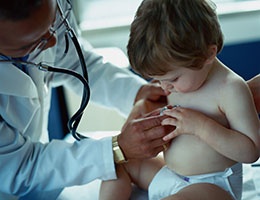 The practice of pediatrics is relatively unique from a risk management perspective. One study placed the risks associated with the practice of pediatrics relative to other specialties as 25th out of 26 specialties with regard to the risk of being sued. However, although the risk of being sued is relatively low, another study found that the risk that a pediatrician may be sued in a given year was 3.1% as compared with 7.4% for all physicians. In the first study, the mean indemnity payment for all physician specialties was $274,887; the median was $111,749. For pediatricians, comparable figures indicated a mean indemnity payment of $562,180, with a median indemnity payment of $187,546. Thus, it appears that pediatricians do not get sued as frequently as other specialties, but that the claims may be more severe when they are brought against them.
The practice of pediatrics is relatively unique from a risk management perspective. One study placed the risks associated with the practice of pediatrics relative to other specialties as 25th out of 26 specialties with regard to the risk of being sued. However, although the risk of being sued is relatively low, another study found that the risk that a pediatrician may be sued in a given year was 3.1% as compared with 7.4% for all physicians. In the first study, the mean indemnity payment for all physician specialties was $274,887; the median was $111,749. For pediatricians, comparable figures indicated a mean indemnity payment of $562,180, with a median indemnity payment of $187,546. Thus, it appears that pediatricians do not get sued as frequently as other specialties, but that the claims may be more severe when they are brought against them.
 Pediatrics is a field circumscribed by the age of the patient; the age of the patient on whose behalf a medical malpractice suit is brought is also a key factor. One study looked at the ages of patients involved in claims and broke them down into three categories: <1 month, 1 month to 1 year, and >1 year. The study found that 49% of cases involved children who were < 1 month old, 24.8% involved children who were between 1 month and 1 year old, and 26.2% involved children who were > 1 year. Thus, nearly three-quarters of the claims were brought on behalf of children less than 1 year old at the time of the event.
Pediatrics is a field circumscribed by the age of the patient; the age of the patient on whose behalf a medical malpractice suit is brought is also a key factor. One study looked at the ages of patients involved in claims and broke them down into three categories: <1 month, 1 month to 1 year, and >1 year. The study found that 49% of cases involved children who were < 1 month old, 24.8% involved children who were between 1 month and 1 year old, and 26.2% involved children who were > 1 year. Thus, nearly three-quarters of the claims were brought on behalf of children less than 1 year old at the time of the event.
The range of medical diagnoses involved in claims brought on behalf of pediatric patients also tends to be somewhat limited. Although this study did not list prevalence by claim frequency, the medical conditions with the highest frequencies included the following (in order, with mean indemnity payments in parentheses):
- Brain damaged infants ($440,379)
- Meningitis ($437,423)
- Birth ($286,407)
- Respiratory problems with newborns ($270,607)
- Premature birth ($250,031)
- Pneumonia ($239,581)
- Asthma ($191,414)
- Specified non-teratogenic anomalies ($186,708)
- Routine health checks ($155,039)
- Appendicitis ($116,285)
Pediatrics may have a high severity rate in the resolution of claims for a number of reasons.
- One of these is the long period of time that the child may require care for a permanent disabling injury. It is expensive to provide 24-hour care for a lifetime.
- The other is a sympathy factor. The death of a child can be a catastrophic event in a parent’s life, and one from which recovery will be slow, if achievable at all. Everyone experiences losses in their lives, but there is nothing quite like the loss of a child. It strikes at a fundamental biological level; e.g., the loss of the continuation of one’s gene pool, the loss of one’s future. Juries understand this and can empathize with the parents who have experienced a loss of this magnitude. The desire to make the parents whole again can drive the results of litigation, and the awards of huge recoveries at trial are indicators of this.
Understanding the risk within your specialty can help you and your organization build a system solution around minimizing medical error, improving patient safety, and thus, limiting your exposure to malpractice litigation.


